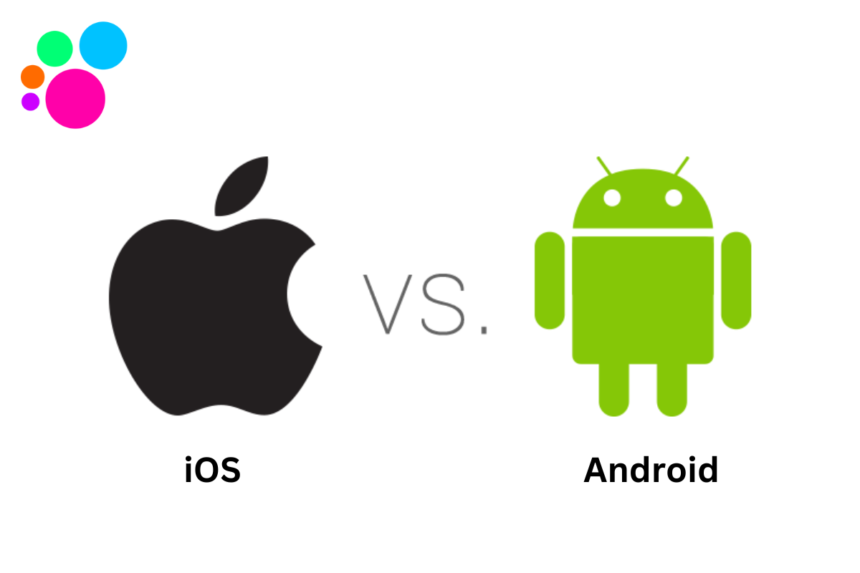Choosing a new smartphone can often feel like navigating a technological minefield, with the two giants, Android by Google and iOS by Apple, at the epicenter of this digital struggle. In this pursuit of the perfect device, one must navigate the fervent loyalty and passionate debates that define the Android vs iOS battlefield. Fear not, fellow tech enthusiast; this article aims to equip you with all the necessary insights to make an informed and wise choice.
iOS:
Exclusively designed for Apple iPhones, iPads, and iPod Touch devices, iOS is celebrated for its sophisticated aesthetics, user-friendly interface, and seamless integration within the broader Apple ecosystem.
Android:
A versatile platform extending its software embrace to an extensive array of devices manufactured by different companies, including Samsung, Google Pixel, OnePlus, and more. Android distinguishes itself with heightened flexibility and unparalleled customization options.

Key distinctions for Android and iOS:
Hardware & Choice:
iOS: Limited hardware alternatives as Apple maintains control over specifications and design.
Android: Boasts a diverse range of devices, catering to varied preferences, needs, and price points.
Customization:
iOS: Constrained customization options within the confines of Apple’s walled garden.
Android: Offers an exceptional degree of customization, empowering users to personalize their experience with customizable launchers, themes, widgets, and more.
App Ecosystem:
iOS: A meticulously curated app market with a robust review process, resulting in fewer privacy concerns.
Android: Embraces a more open app ecosystem, though sideloading may introduce potential security challenges.
Updates & Support:
iOS: Prides itself on timely updates, ensuring consistent performance and security across the Apple device spectrum.
Android: Update rollout varies by device manufacturer, potentially leading to fragmentation and delayed updates.
Integration with Other Devices:
iOS: Seamlessly connects with other Apple products such as Macs and iPads, fostering a cohesive ecosystem.
Android: Compatible with an array of devices, although integration may not be as seamless.
Price:
iOS: iPhones often come with a premium price tag, reflecting Apple’s commitment to high-quality materials and craftsmanship.
Android: Offers a broad spectrum of price points, ranging from budget-friendly options to flagship devices, catering to a wider audience.
Ecosystem Lock-In:
iOS: While seamless integration is an advantage, the iOS ecosystem can lead to a certain level of lock-in. Switching to a different operating system may require adapting to new apps, repurchasing software, and adjusting to a different workflow.
Android: Embraces a more open ecosystem, allowing users to switch between devices and manufacturers without a significant disruption in their digital life.
Innovation and Features:
iOS: Known for pushing the envelope with innovative features, Apple often introduces cutting-edge technologies in its devices. However, these advancements may take some time to become industry standards.
Android: Being an open-source platform, Android devices often pioneer new features, and manufacturers compete to introduce the latest technologies. This results in a faster adoption of innovations across a variety of devices.
Gaming Experience:
iOS: Renowned for offering a robust and consistent gaming experience, with a well-curated App Store featuring a plethora of high-quality games optimized for Apple devices.
Android: Boasts a diverse gaming landscape with a wide range of titles and the flexibility to choose from various app stores, though the quality control may vary.
Voice Assistants:
iOS: Siri, Apple’s voice assistant, is deeply integrated into the iOS ecosystem, offering seamless voice commands and a growing list of functionalities.
Android: Google Assistant, the Android counterpart, excels in its integration with Google services and provides a more conversational and context-aware experience.
File Management:
iOS: Known for a streamlined and user-friendly file management system, catering to those who prefer simplicity and ease of use.
Android: Offers a more open file system, allowing users to access and manage files with greater flexibility, appealing to those who prefer a hands-on approach to their data.
Conclusion
Remember, the “best” operating system hinges on your unique requirements and inclinations:
Opt for iOS if you value simplicity, curated apps, seamless integration with Apple devices, and swift upgrades.
Embrace Android if customization, a vast selection of devices at different price points, and a more open app environment appeal to you.
Ultimately, the most fitting choice emerges through hands-on exploration. Visit a store, feel the devices, and ascertain which platform aligns with your intuition and preferences. Your ideal phone is the one that seamlessly integrates into your lifestyle and fulfills your demands – that is the true victor.
Bonus Tip: Consider your existing technology ecosystem. If Apple devices already grace your collection, iOS may offer a smoother transition. For those open to experimentation with different brands, Android unveils a world of possibilities.






